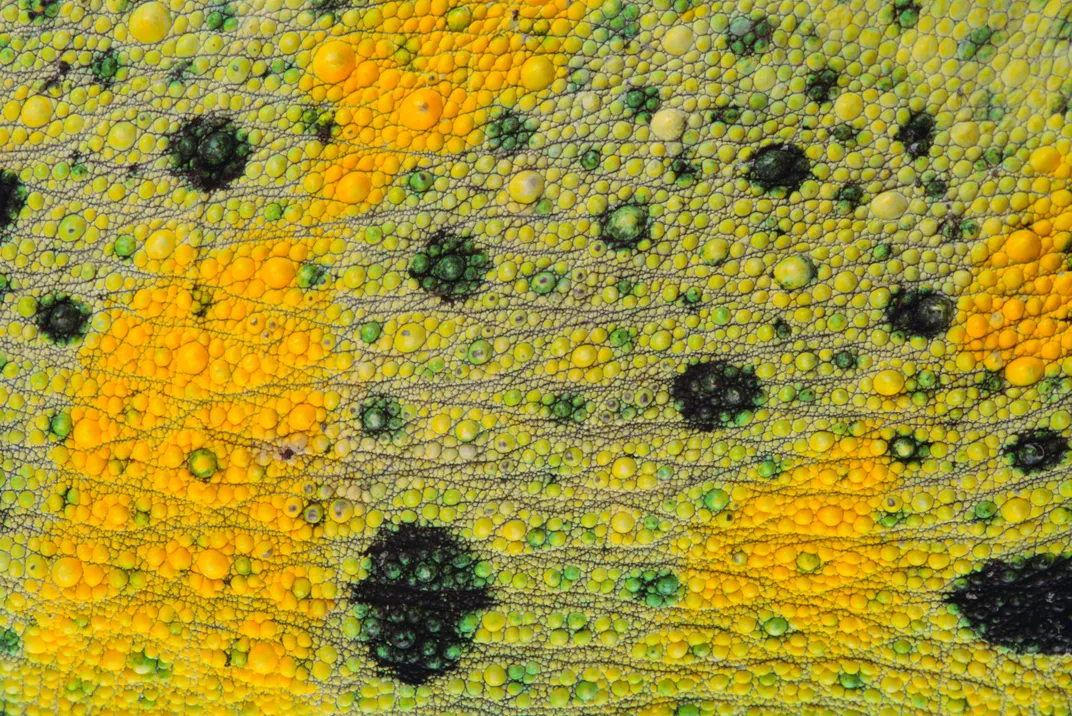We Finally Know How Chameleons Change Their Color
Chameleons’ secret involves tiny crystals under their skin
/https://tf-cmsv2-smithsonianmag-media.s3.amazonaws.com/filer/e6/bb/e6bb04ce-19eb-4235-ae2f-e1e8df2634df/42-17307951.jpg)
Scientists in search of the key to chameleons’ incredible color-changing ability say they’ve found the answer: a lattice of nanocrystals beneath the lizards’ skin that reflect different wavelengths of light.
As BBC News’ Jonathan Webb reports, reptiles are known to shift hues by two means. Warm and dark colors come from adjusting the dispersal of dark or light pigment in cells within skin layers; blues and whites, on the other hand, deemed “structural colors,” emerge “from light bouncing off physical elements” in their skin.
Chameleons can adjust some skin pigments to appear lighter or darker. But until recently, scientists assumed the same sort of process was happening when the animals radically adjust their appearance into bright colors, like reds and yellows. Not so, argues the study, out this week in the journal Nature Communications.
In observing and dissecting panther chameleons, the team of Swiss scientists found that the animals have “two superposed thick layers of iridophore cells—iridescent cells that have pigment and reflect light,” reports NBC News. Within these iridophore cells are a variety of nanocrystals that work together, according to the study’s lead author, Michel Milinkovitch, “as a selective mirror”.

A chameleon can adjust the wavelengths of light reflected in these tiny crystals by either tightening or relaxing their skin, which changes the spacing of the cells. “Light will go through except for very specific wavelengths,” Milinkovitch told BBC. “If the distance between the layers is small, it reflects small wavelengths, like blue; if the distance is large it reflects larger wavelengths - for example, red.”
The team watched this process in both live animals and in samples of chameleon skin. When they tensed the skin by drying it up, they saw the same drastic change in color apparent in live panther chameleons confronting, for example, a male competitor.
The study also found that beneath the lattice of crystals was a deeper skin layer that reflects near-infrared light, which likely helps the lizard to stay cool in the heat of the sun. As Webb points out, the combination of color changing crystals and a reflective skin layer appears to be unique to chameleons; other lizards just have one or the other.
And here’s a little bit of chameleon trivia: the animals’ radical color changes (which can take minutes to fully unfold) aren’t performed to blend in with their surroundings as children’s books might have us believe; rather, they change outfits to communicate to other lizards and to react to temperature or mood. And not all chameleons can go Technicolor—some can only range from green, brown and gray. But panther chameleons, found in Madagascar and the focus of this study, can exhibit exotic blues, yellows, greens and reds. And now we can thank crystals for the show.
/https://tf-cmsv2-smithsonianmag-media.s3.amazonaws.com/accounts/headshot/lauraclark.jpeg)
/https://tf-cmsv2-smithsonianmag-media.s3.amazonaws.com/accounts/headshot/lauraclark.jpeg)